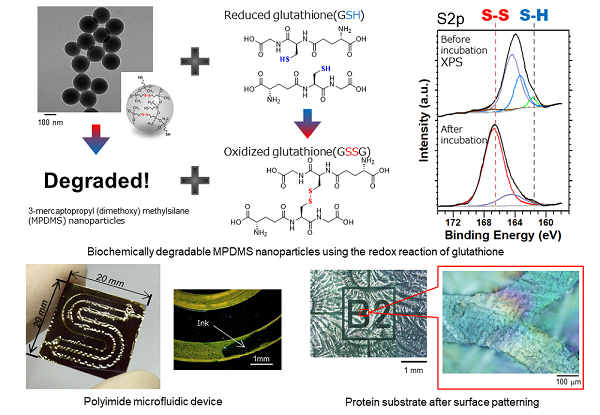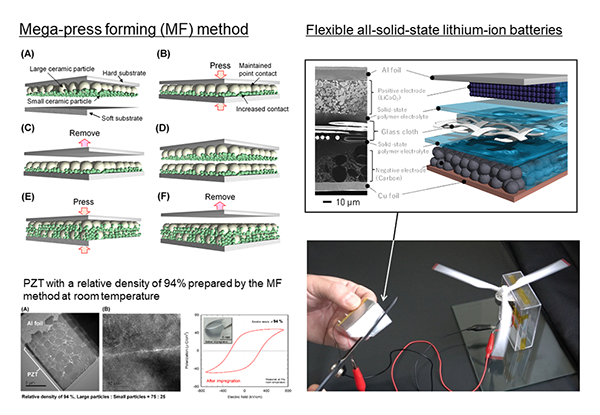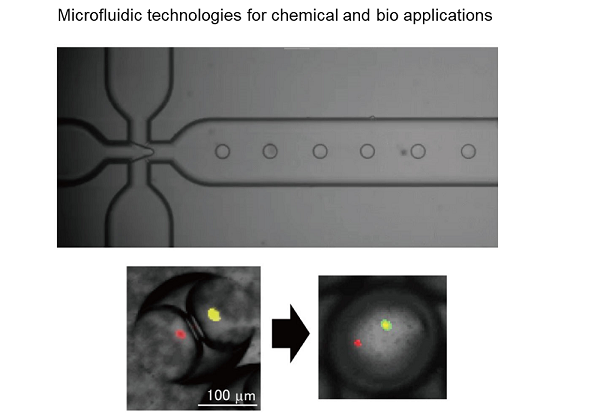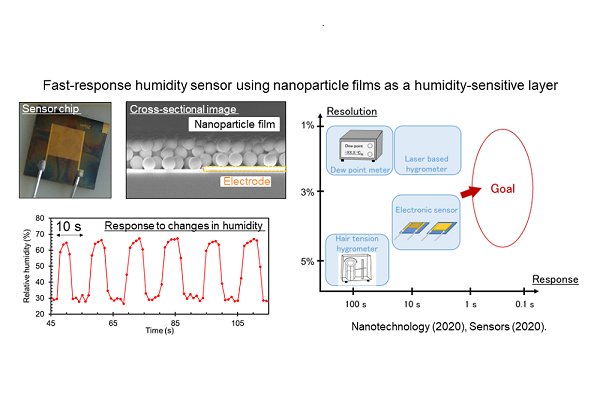Well-being Device Research Team
Team Member
Researcher
Technical Staff
- SUZUKI Satoru
- TAKAHASHI Naomi
- AKIYAMA Akira
Research Assistant (RA)
- MATSUNAGA Kouki
- IMANO Naruto
- MIYAUCHI Hiromasa
Technical Trainee
- OKUMURA Reo
- MATSUO Yuuki
Office Assistant
- KAMEI Tomoko
Collaborating Visitors
- TAKAGI Yuka
Aims and contents of our research
We are engaged in research and development of materials, devices, and systems for applications on health care, chemistry, and bio, with the aim of realizing a social environment in which people can continue to be physically, mentally, and socially healthy. We are focusing on development of creative micro-nanodevices that combine nanomaterials, microfluidic technologies, and MEMS in order to realize high-speed and high-performance micro-nanodevices for social implementation in the fields of biometrics and precision medicine. In particular, we are promoting the realization of minimally invasive medical care by in-vivo remote control using electromagnetic waves, the development of flexible all-solid-state lithium-ion batteries for wearable and IoT devices, the advancement of preventive medical services and sports engineering through biological sensing and healthcare monitoring using chemical and biosensors.
Core technologies
- Drug delivery systems (nanoparticles, microneedles)
- Nanoimprinting on biomaterials
- Mega-press forming (MF) method
- Flexible all-solid-state lithium-ion batteries for wearable and IoT devices
- Formation of monodisperse droplets and fine particles by microchannels
- Encapsulation using droplets
- Rapid prototyping for fabrication of microchannels
- Fast-response humidity sensor using nanoparticles as a humidity-sensitive material and its applications
- Nanoparticle-based electronic devices
Priority research themes
Representative patents and articles
- JP7272671, Brittle material structure,
Muneyasu Suzuki, Jun Akedo, and Tetsuo Tsuchiya. - JP6446752B2, (USA)10158143, Method for producing lithium solid state battery、
Muneyasu Suzuki, and Jun Akedo, Takashi Takemoto - JP6260982B2, Particle-oriented ceramics,
Muneyasu Suzuki, and Jun Akedo - JP5999738B2, Immersion imprint method,
Harutaka Mekaru and Hiroshi Hiroshima - JP5062781B2, Imprint method and apparatus using ultrasonic vibration,
Harutaka Mekaru, Masaharu Takahashi, and Ryutaro Maeda
- Harutaka. Mekaru:
"Control of the particle size distribution of organosilica nanoparticles using sonochemistry",
Mater. Today Commun. 34 (2023) 105215 - Harutaka Mekaru:
"Effect of agitation method on the nanosized degradation of polystyrene microplastics dispersed in water",
ACS Omega 5 (2020) 3218-3227. - Harutaka Mekaru, Akitaka Yoshigoe, Michihiro Nakamura, Tomohiro Doura, and Fuyuhiko Tamanoi:
"Biodegradability of Disulfide-Organosilica Nanoparticles Evaluated by Soft X-ray Photoelectron Spectroscopy: Cancer Therapy Implications",
ACS Appl. Nano Mater. 2 (2019) 479-488. - Harutaka Mekaru, Jie Lu, and Fuyuhiko Tamanoi:
"Development of mesoporous silica-based nanoparticles with controlled release capability for cancer therapy",
Adv. Drug Deliv. Rev. 95 (2015) 40-49. -
Muneyasu Suzuki, Shin-ya Shibata, Kanako Nakajima, Yoshiyuki Kobayashi, Harutaka Mekaru, and Hirobumi Ushijima:
"Plantar pressure measuring devices powered by flexible all-solid-state batteries",
Jpn. J. Appl. Phys. 62 (2023) SG1038. - Muneyasu Suzuki, Yasuyuki Kusaka, Tetsuo Tsuchiya, Hirobumi Ushijima, Jun Akedo:
"Aggregate ceramic films produced at room temperature by press forming",
J. Am. Ceram. Soc. 103(6) (2020) 3449-3916. - Muneyasu Suzuki:
"Polarization and leakage current properties of high quality bismuth sodium titanate single crystals and polycrystalline ceramics",
J. Ceram. Soc. Japan 123(1) (2015) 9-16. - Hirotada Hirama, Yuya Ishikura, Shinya Kano, Masanori Hayase, and Harutaka Mekaru:
"Monodispersed sodium hyaluronate microcapsules for transdermal drug delivery systems.",
Mater. Adv. 2 (2021) 7007-7016. - Hirotada Hirama, Taku Satoh, Shinji Sugiura, Kazumi Shin, Reiko Onuki-Nagasaki, Toshiyuki Kanamori, and Tomoya Inoue:
"Glass-based organ-on-a-chip device for restricting small molecular absorption",
J Biosci Bioeng 127(5) (2019) 641-646. - Hirotada Hirama, Hokichi Yoshioka, Yoshihiro Matsumoto, Takuya Amada, Yousuke Hori, Kenichhiro Ohtaki, Ming Lu, and Tomoya Inoue:
"Design, Fabrication, and Performance of an Optimized Flow Reactor with Parallel Micropacked Beds",
Ind. Eng. Chem. Res. 56(48) (2017) 14200-14206. - Hirotada Hirama, Satoshi Wada, Jiro Shimamura, Yusuke Komazaki, Tomoya Inoue, and Toru Torii:
"Surface modification of a glass microchannel for the formation of multiple emulsion droplets",
Microfluidics and Nanofluidics 21(5) (2017) 91. - Hirotada Hirama and Tomoya Inoue:
"Core-Shell Structure Formation from Droplets by Droplet Shrinkage and Spontaneous Emulsification",
Chem. Lett. 46(4) (2017) 460-462. - Yusuke Sugiura, Hirotada Hirama, and Toru Torii:
"Fabrication of Microfluidic Valves Using a Hydrogel Molding Method",
Sci. Rep. 5 (2015) 13375. - Hirotada Hirama and Toru Torii:
"One-to-one encapsulation based on alternating droplet generation",
Sci. Rep. 5 (2015) 15196. - Shinya Kano and Harutaka Mekaru:
"Noncontact Rapid Vapor Sensor Using Capillary Condensation to Monitor Ethanol in Sanitizer",
IEEE Electron Device Lett. 43 (2022) 1323-1326. - Shinya Kano and Harutaka Mekaru:
"Proton transport over nanoparticle surface in insulating nanoparticle film-based humidity sensor",
Jpn. J. Appl. Phys. 61 (2022) SE1011. - Shinya Kano, Nutpaphat Jarulertwathana, Syazwani Mohd-Noor, Jerome K Hyun, Ryota Asahara and Harutaka Mekaru:
"Respiratory Monitoring by Ultrafast Humidity Sensors with Nanomaterials: A Review",
Sensors 22(3) (2022) 1251 - Shinya Kano and Harutaka Mekaru:
"Liquid-dependent impedance induced by vapor condensation and percolation in nanoparticle film",
Nanotechnology 33 (2022) 105702. - Shinya Kano and Harutaka Mekaru:
"Nonporous Inorganic Nanoparticle-Based Humidity Sensor: Evaluation of Humidity Hysteresis and Response Time",
Sensors 20(14) (2020) 3858. - Shinya Kano:
"Respiratory rate monitored by mask-type device",
Safety&Health Digest 66(6) (2020) 2-5.



